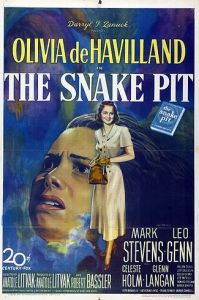 There is a lineage of psychological dramas most notably including the likes of Shock Corridor and One Flew Over the Cuckoos Nest. But one of their primary predecessors was The Snake Pit which is a haunting, inscrutable and thought-provoking film in its own right.
There is a lineage of psychological dramas most notably including the likes of Shock Corridor and One Flew Over the Cuckoos Nest. But one of their primary predecessors was The Snake Pit which is a haunting, inscrutable and thought-provoking film in its own right.
But rather than trying to sum it up with words, it’s necessary to look deeper at what makes this such a potent film and it begins most obviously with Olivia De Havilland. She undoubtedly gives the best performance of her career — in so many ways drifting so effortlessly across the emotional spectrum. She’s either sane or “crazy” with fits of paranoia and inner turmoil, voices sounding off in her head and the like. But the most beautiful things are the moments when all the drama derives from the look on her face, a furrowed brow or a panic-stricken reaction we cannot fully understand.
That’s why it takes us the entire film to comprehend what is actually happening and it’s wonderful that we enter her story while she is in a sanitarium. Why and how she got there we don’t know right away, so as an audience there’s a similar sense of disorientation. Several reliable points of reference exist early on. Those being the genial Dr. Kik (Leo Genn)and Virginia’s concerned husband Robert (Mark Stevens) who visits her during every possible hour.
The film does intermittently feel disjointed but that hardly seems due to faulty storytelling and more a convention of Virginia’s narrative. It all comes to us in incoherent bits. In reality, months have passed but her memory is poor, causing her to lose track of the days. She drifts in and out of different wards and soon forgets the people and places that have been there all along. Furthermore, her progress waxes and wanes, with special visits from her husband and the faint chance of being released. Then in her darkest moments come electroshock therapy and even a straight jacket confining her in the depths of the sanitarium.
Anatole Litvak would hardly be considered an auteur but he still finds a way to heighten the tension with whip pans and nightmarish imagery when necessary. A pounding score adds yet another layer of anxiety reverberating with a vengeance, most memorably to simulate the jolts of electroshock therapy. But the greatest compliment that I have for his film is that it knows when to simply sit back and watch, like many of the great Classical Hollywood films. It lets its story, actors, and script all work and, in this case, they develop something with lasting depth.
Earlier I alluded to The Snake Pit being part of a lineage including Shock Corridor and One Flew Over the Cuckoo’s Nest. It contains similarly shocking revelations about the reality behind sanitarium walls except they feel more realistic than the former film. Furthermore, De Havilland is surrounded by a wide array of odd bodies and patients with all sorts of psychoses rather like Randle McMurphy. But although there are some antagonistic people, her problems stem partially from the system around her and mostly from the pain buried deep within her own past.
It’s Dr. Kik who is able to dredge up the truth hidden inside of her over time. His calming, reassuring voice balanced with his psychoanalytic practices are able to work on Virginia’s psyche systematically. But in the same instance, it’s easy for her to get lost among the masses. Nurses do their jobs, doctors pass verdicts but they’re woefully understaffed and overworked.
The film’s resolution is actually hidden within its title. Because like the madmen of old, Virginia was thrown into a snake pit of her own that, far from driving her crazy, revealed to her that she must, in fact, be sane — at least compared to many of those around her. It’s up to the viewer to decide, aside from the happy denouement, if this is a troubling conclusion that the film comes to or not.
However, it’s paramount to note The Snake Pit’s conclusion on personal trauma and mental illness, based on childhood experiences. A lot of Virginia’s struggles came out of guilt and dysfunctional relationships with her parents. Yes, this is the punchline of the movie, but I only say this to point out how frightening or more precisely, how universal that revelation make this movie. Virginia’s parents weren’t altogether bad people and the reality is that all of us will face personal tragedy. We will have our share of guilty consciences too.
It’s how we cope with those things that matter most because it’s going to happen. We can hide it but we can’t escape it. All of us are broken in one way or another — even if we don’t want to admit it. That’s part of what The Snake Pit begins to bring to light.
4/5 Stars

I absolutely love this movie. My favourite Olivia de Havilland role for sure. I feel as if mental illness is portrayed as respectfully and as comprehensive as it could have been for the time it was made. Definitely need to rewatch it 🙂
LikeLiked by 1 person
Thanks for your comment! I agree De Havilland is great. It’s a wonderful performance with a great deal of nuance.
LikeLiked by 1 person
Awesome review! Wonderful insight.
LikeLiked by 1 person
I appreciate it! Thanks for visiting. Really enjoyed this film. If you haven’t seen this I’d definitely recommend it. I still want to see Too Each His Own with De Havilland.
LikeLiked by 1 person
It’s definitely ahead of its time thematically. Still can’t believe de Havilland’s sister is Joan Fontaine.
LikeLiked by 1 person
Pingback: Classic Movie Beginner’s Guide: Olivia de Havilland | 4 Star Films